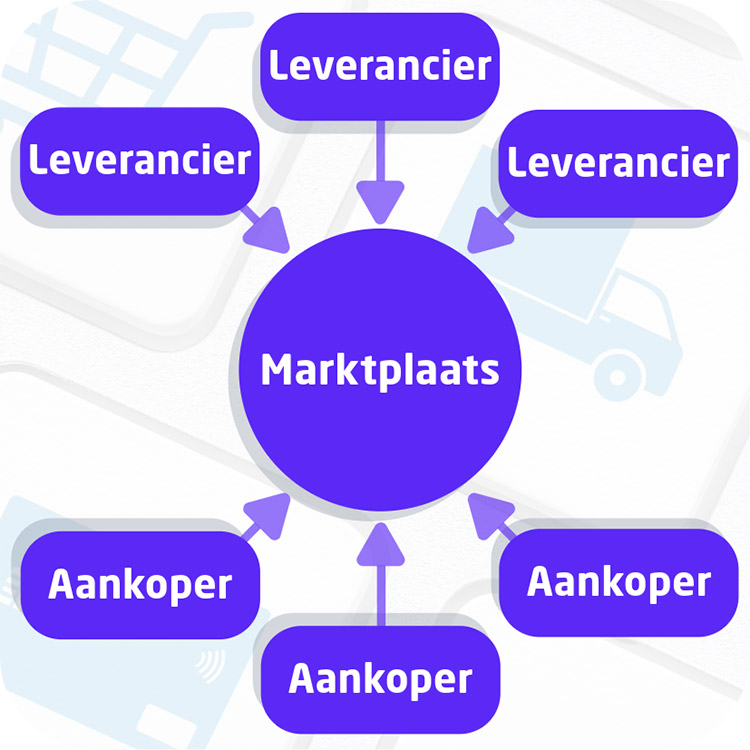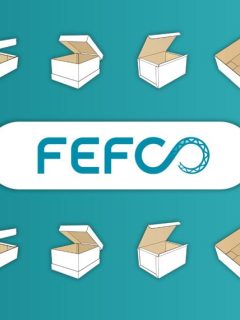E-procurement is all about making your purchasing process completely electronic – via a centralised system. This gives you a lot of advantages as a company. Buying your orders faster and easier? From now on, it can be done in no time. At RAJA, we also believe in the power of e-procurement. That is why we offer you 4 solutions to digitise your purchasing process. Below we show you step by step how e-procurement can help your company move forward even faster.
1. What is e-procurement?
E-procurement stands for purchasing goods or services using IT systems. Usually, these processes take place via the internet. This is particularly relevant to the B2B sector. E-procurement was therefore developed primarily to facilitate the procurement of goods between companies.
Before digitalisation, many separate steps were needed in a company to order goods. This was often done via e-mail, telephone or even by letter. At each of these steps, (human) errors could still occur. Nowadays, we can shorten this whole process a lot. Thanks to e-procurement, purchasing goods is largely done through an automated process, sometimes with just the push of a button.
- E-procurement = the entire process of digital procurement flows from order to payment.
- E-fulfillment = the electronic processing of orders.
- ERP = (Enterprise Resource Planning) software solution to link all processes in a company (such as e-procurement).
- EDI = (Electronic Data Interchange) electronic exchange of business documents, such as orders or invoices. EDI messaging always follows an agreed standard so that the software systems of the companies communicating with each other speak the same, uniform language.
- Procure to Pay (P2P) = the process by which a company can purchase the goods and services it needs from its suppliers.
- Source to Pay (S2P) = represents the entire procurement workflow from the moment a company identifies a need for a product (sourcing) to the final payment to the supplier (pay).
2. What are the benefits of e-procurement?
E-procurement offers a lot of advantages for any business over traditional purchasing processes. Take a look…
- Automate your purchasing: This forms the absolute core of e-business. You can save considerable time and resources. This way, your staff is available for more strategic tasks. By assigning roles and responsibilities to your (purchasing) colleagues, you can completely streamline your purchasing process. Moreover, with this digitised process, you reduce the risk of ordering errors.
- Benefit from a personalised offer: the products in your e-business tool are usually fully tailored to your company account, allowing you to benefit from a personalised purchasing experience. You often only see the products that are useful to you. Easy and convenient!
- Improve your insights: e-procurement gives your company a full accounting overview of the purchasing processes. In addition, you can track the status of your orders more accurately and consult your order history easily.
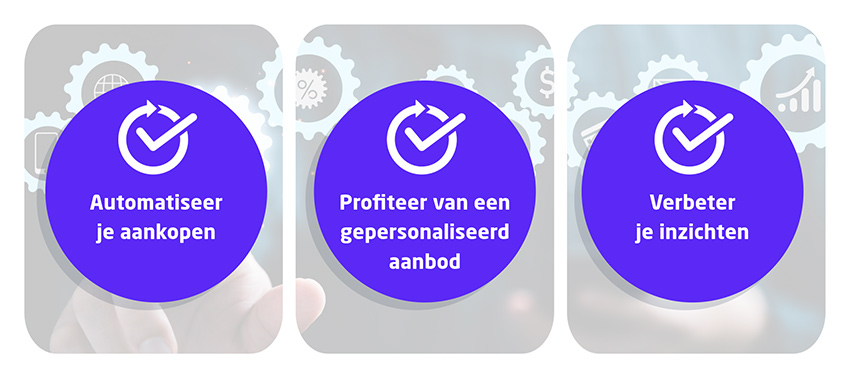
3. What solutions does RAJA offer?
With www.rajapack.nl, RAJA offers a complete one-stop shopping experience for all your packaging, warehouse supplies and office supplies. In doing so, our customers can also choose from various e-procurement solutions, tailored to the needs of their purchasing teams.
Good to know: all these solutions can be designed and integrated for you by RAJA free of charge. To do so, we use Saas (Software as a service), which means you don’t have to install any software. Our e-procurement solutions are all accessible via the cloud and thus navigable from a browser. You can choose from the four solutions below.
► Purchase management via rajapack.co.uk
This most closely resembles the interface of our standard webshop. It allows you to consult all our products, view price agreements and simplify your purchasing process. Using our integrated search engine, you can browse through our entire up-to-date catalogue.
- Ideal for those not yet using an e-procurement tool.
- Automatic update of RAJA’s stocks and prices.
- Consult your purchase lists, invoices and order history online.
- Suitable for simple purchasing teams.
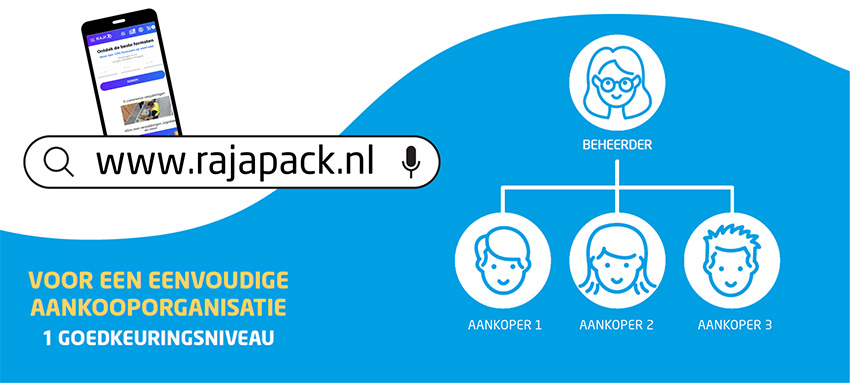
► MyRAJAShop
This solution gives you all the benefits of e-business, but within your familiar web account at www.rajapack.nl. Using your personal RAJA account, you can create a fully digital purchasing team and determine approval processes. This way, as an administrator or lead buyer, you retain all control over your budget.
- Ideal for those not yet using an e-procurement tool.
- Customised product range (always up-to-date) and overview of your preferred rates.
- Comprehensive budget management and set-up of approval processes.
- Suitable for more extensive procurement organisations.
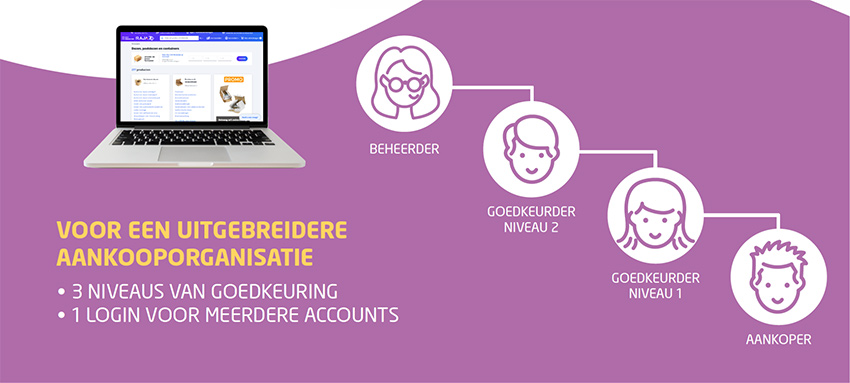
► Hosted Catalog – static catalogue
From your multi-supplier purchasing system or ERP, you can access a selection of RAJA products at your preferred prices. Depending on your validation process, you can then easily place orders. However, this solution requires manual adjustment every time you update prices or products. This is why it is also referred to as a ‘static catalogue’. For this, RAJA provides you as a customer with a BMEcat, CSV or Excel file that you then have to upload yourself in your purchasing system.
- Ideal for those already using an e-procurement tool.
- Fully customised product offerings, including preferential rates.
- Manual update required for new products or prices.
- Suitable for those who want to standardise their purchasing process with multiple suppliers.
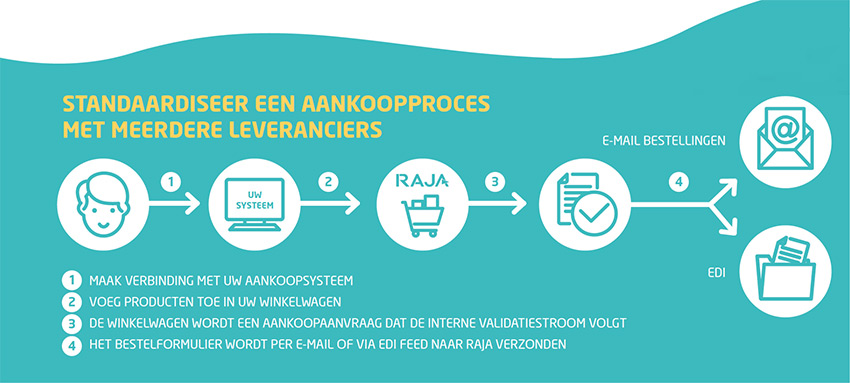
► Punch Out Catalog – dynamic catalogue
Punch Out offers a dynamic solution that works from your own purchasing system or a multi-supplier platform. Within such a platform, you get access to a personalised version of rajapack.co.uk where all your price terms can be found. Unlike a hosted catalogue, here there will be an automatic update of all RAJA data. You therefore benefit from a familiar shopping environment as well as direct access to a customised and up-to-date RAJA product catalogue.
- Ideal for those already using an e-procurement tool.
- Fully customised product offering, including preferential rates.
- Automatic update by RAJA of product information.
- Suitable for those who want to maximise their purchasing process.
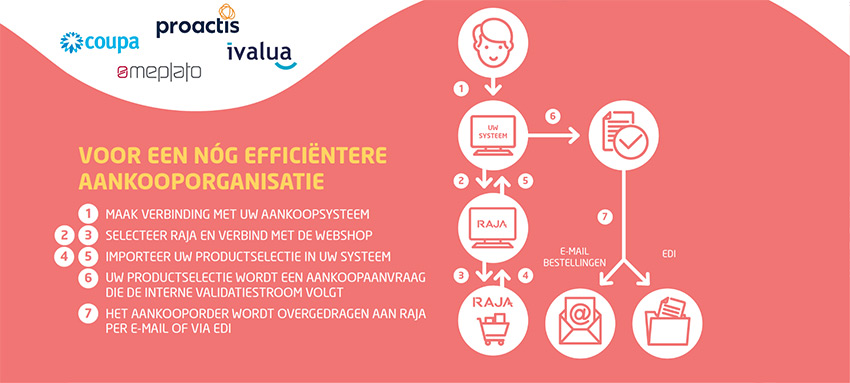
4. How does e-procurement work?
All the procurement steps you used to have on paper are fully digitised with e-procurement. For example, an e-procurement system can give you insight into offers, approval processes, transactions, payments and reporting. We can distinguish 2 types of procurement systems: systems according to the type of user connection (how do people use it?) or according to the type of user profile (who uses it?).
4.1 Systems according to user connection type
1) Closed systems: here, only 2 companies have access to the same system so that they can communicate and do business with each other. Other companies are excluded. This architecture offers a wide range of services and is worthwhile if you want to establish a long-term collaboration for one supplier.
2) Semi-open systems: these are usually developed by larger retailers. Here, customers are given access to a portal on which they can buy goods. Semi-open systems are designed as buy-side or sell-side systems (which you will find out more about below).
3) Open systems: these are the so-called many-to-many solutions. In these, the catalogues of different suppliers are integrated into an open e-procurement system. Manufacturers can offer their goods and buyers can specify their requirements at the same time. Think of it a bit like a marketplace managed by a third party.
4.2 Systems according to user profile type
1) Sell-Side System: this is also called a supplier system because the initiative for the procurement comes from the supplier (a company like RAJA, for example). The supplier provides the procurement platform that customers can use. In doing so, it determines both the product range and prices. The supplier also bears the cost of creation and maintenance.
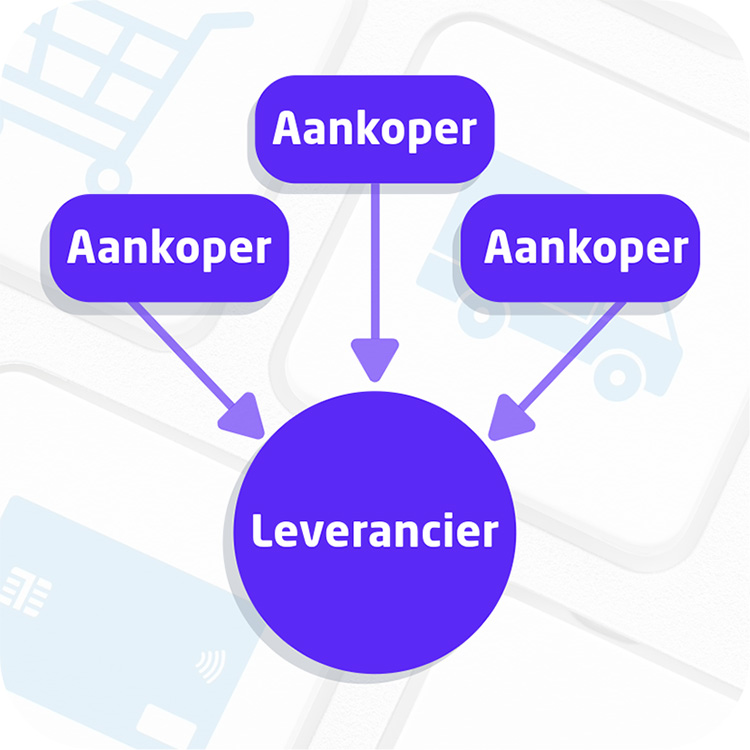
2) Buy-Side System: this refers to a system created by the buy-side of a company. Here, the buyer can formulate special requirements that a supplier, product or service must meet. This is especially applicable in large companies where there are large purchase volumes. Different suppliers then have the opportunity to display their products in the system via a tender, for example.
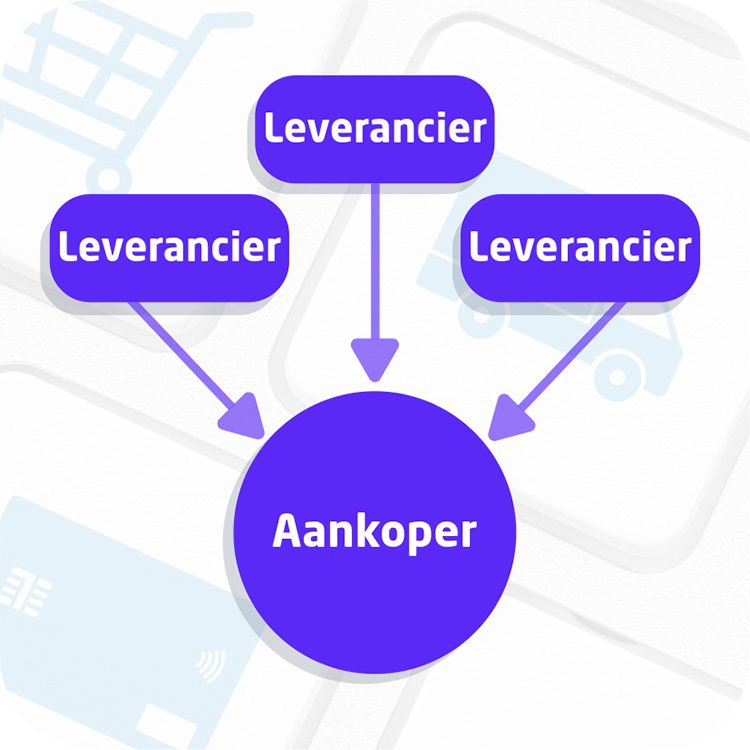
3) Many-to-Many System: this is best compared to a marketplace. A third independent party will provide the platform and charges all fees for it. Both buyers and suppliers can connect to this system. Since multiple participants use the marketplace, costs are reduced and buyers can easily compare suppliers’ prices.
